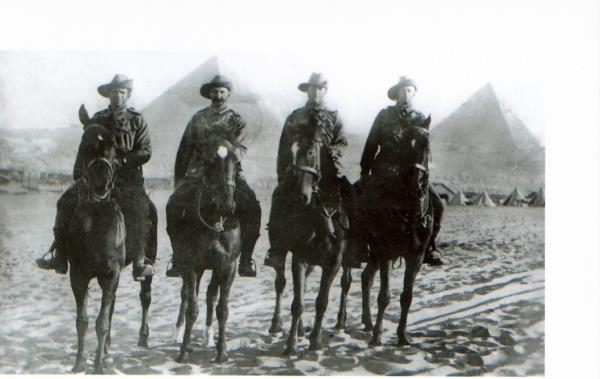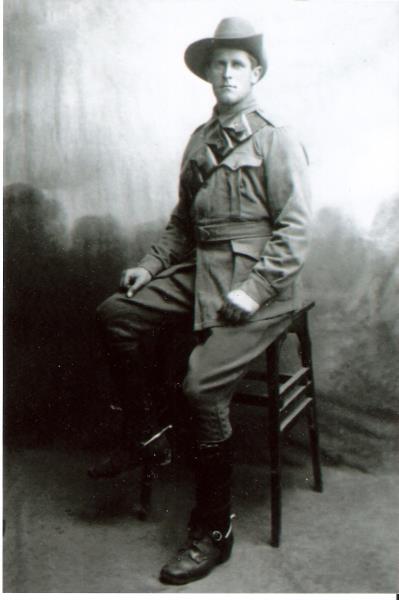
By NARELLE COULTER
THE ghosts of Lighthorsemen past ride on at Dandenong High School, their memory preserved in the school’s official colours – dark blue, light blue and red.
The colours – representing loyalty, faith and courage – pay homage to the school’s founding principal Percy Langford, a member of the 4th Light Horse Regiment and a veteran of the horrors of the battle for Gallipoli.
Percival Langford was a 30-year-old teacher at University High School when he enlisted for war on 18 August 1914 joining the A Squadron of the 4th Light Horse as a private.
The regiment sailed from Melbourne on 19 October 1914 disembarking in Egypt on 10 December.
According the Australian War Memorial the Light Horse was considered unsuitable for the initial operations at Gallipoli, but was subsequently deployed without their horses to reinforce the infantry.
The regiment landed in May and its squadrons were scattered to reinforce the infantry battalions already fighting the Turks.
The regiment was not reunited until 11 June.
Much of the regiment’s time at Gallipoli was spent defending the precarious Anzac position, most frequently around Ryrie’s Post.
In a letter written home to his University High School students Private Langford writes that he could hear the boom of guns as his boat approached the Gallipoli shore.
“The flash of the guns followed by the heavy boom gave out the impressions of continuous thunderstorm,“ he wrote.
“That night we dug in, but before we had done it three of our men were hit, one of them fatally.
“Three of us dug a hole about two feet deep and sufficiently long to enable us to lie down.
“However, it was only wide enough to allow us to lie on our sides. Before morning we were very stiff.
“We dug four separate ’dug-outs’ during the day and were heartily sick of the task before night.
“We were nicely and finally settled for the night, having returned with blistered hands and very tired bodies, we got work to prepare for the support trenches.
“We moved into trenches themselves about 8am and relieved troops who had been in them for a considerable time.
“One trench in front of us was completely filled with their dead bodies, but I do not wish to give you harrowing details of the state of affairs.
“You will be able to form some idea of the number of dead lying in front when I tell you that we collected 185 rifles from dead men on half the ground between us and the Turks.
“It was estimated that 7000 Turks lay dead in front of our trenches.“
On 24 May and by now a Lance Corporal Langford witnessed the truce brokered between the warring sides to allow the dead to be buried.
“Midway between the trenches… men of either side stood with, on one side, the Red Cross flag and on the Turks the Red Crescent. They formed the dividing line between the two forces.
“Burial operations occupied the Turks until late in the afternoon. As soon as it was over a perfect hail of bullets of was fired by the enemy.
“During my stay in the trenches… I did not shave, washed once in half a cup of water, observed and slept.
“The first swim in the sea after coming out, was, as the girls would say ’heavenly’.
“I wallowed, regardless of shrapnel, which was bursting at the other end of the beach. Never have I had such a swim before.“
The 4th Light Horse didn’t leave the peninsula until 11 December.
For Percy Langford active service was over. He was discharged as medically unfit and returned to Australia on 29 January 1916.
He saw out the rest of the war at the Melbourne Recruiting Centre, where he was promoted to Lieutenant.
After the armistice was declared, Percy returned to the education department and was given the task of setting up a new high school at Dandenong.
The school was opened in March 1919 with eighty pupils.
In a book published in 1960 on the school’s 40th anniversary, Percy Langford wrote an account of how the school colours were settled.
“When I joined the 4th Light Horse regiment our two colours had been red and white but on being sent to the Peninsula we had so many reinforcements after the evacuation that it was decided to divide the Light Horse into two sections (one went to Palestine and the others through France) and that meant we had four colours – red, white and two blues.
“In those days to register school colours there had to be three, so one of the girls suggested we take my regimental colours and combine them, omitting the white and arranging the other three to suit ourselves.“
Percy Langford remained in charge at Dandenong until 1934.
He later led schools at Midura and Frankston before returning to Dandenong in the 1950s. He died in 1964.
President of the Ex-students Association Greta Jungwirth said Percy Langford’s influence on the school was profound and long lasting.
“Coming from a teaching and military background, Mr Langford introduced to the students an ethos of industry, self-discipline, school spirit and pride in achievement.
“This visionary approach has infused the aims and efforts of generations of students and exists to this day.
“There is much for which to thank and honour him.“









